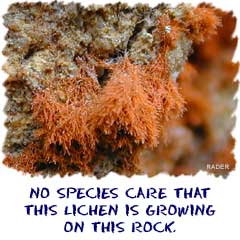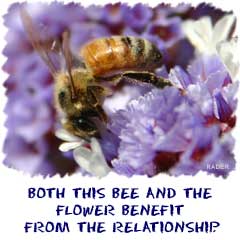
Relationships Between Organisms
 Everything on Earth doesn't exist in its own little bubble. Species interact every day. That interaction is a vital part of how organisms develop and change over time. When you study species, it is important to watch the way they interact with their surroundings. There are four basic types of relationships that living things have with one another.
Everything on Earth doesn't exist in its own little bubble. Species interact every day. That interaction is a vital part of how organisms develop and change over time. When you study species, it is important to watch the way they interact with their surroundings. There are four basic types of relationships that living things have with one another.
Commensalism
Sometimes one species can benefit from a relationship and not hurt the other. That relationship describes commensalism. I've got a nice looking branch that no one's using. A plant comes over and settles in. It uses my branch as a place to live. But what do I care? It doesn't bother me. That's what commensalism is all about. One plant gets a place to live and the other doesn't care and is not hurt.Competition
This relationship is when two species are competing for the same resources. If there are only ten trees with fruit and I am better at reaching the fruit than you are, sorry, you don't get any. When you don't get any fruit you die. That's just the way nature works. It could go the other way though. If I kill all of the trees with the high fruit and only low fruit is left, you win. Competition usually happens when you have a limited amount of resources. There is one important idea to remember. Sometimes no one wins. Sometimes if everything is even it can be a stalemate and both species compete, but both survive. Imagine if we are different species, but have the same skills. No one would be a winner in that case.
Mutualism
The heart of mutualism is that two species live together in harmony. Both species receive an advantage by working with the other. It's wonderful. It's beautiful. More importantly, it helps them both survive. We previously spoke about the relationships between bugs and plants. That often happens as a mutualism type of relationship. We suppose you could also use rescue dogs as an example. The masters take care of the dogs and the dogs learn how to save people. Everyone benefits in the end.Predator-Prey
There many examples of predator-prey relationships: wolves eating rabbits, frogs eating insects, even a goat eating grass. Grass could be considered the prey. Somebody eats someone else. It's not pretty, but it does encourage the development and advancement of species.Parasitism
There's a special type of predator-prey relationship called parasitism. Now you should think about all the creepy crawlies like fleas, viruses, and mosquitoes. They all feed off a host, not killing it right away but slowly sucking the life out of it. Parasites help no one but themselves.
► NEXT PAGE ON SCIENTIFIC STUDIES
► NEXT STOP ON SITE TOUR
► RETURN TO TOP OF PAGE
► Or search the sites...
► NEXT STOP ON SITE TOUR
► RETURN TO TOP OF PAGE
► Or search the sites...
Related Video...
Ravens and Tortoises (USGS Video)
Encyclopedia.com (Predation):
http://www.encyclopedia.com/topic/Predation.aspx
Wikipedia (Commensalism):
http://en.wikipedia.org/wiki/Commensalism
Wikipedia (Mutualism):
http://en.wikipedia.org/wiki/Mutualism_(biology)
Wikipedia (Competition):
http://en.wikipedia.org/wiki/Competition_(biology)
Wikipedia (Predation):
http://en.wikipedia.org/wiki/Predation
Encyclopædia Britannica (Competition):
http://www.britannica.com/EBchecked/topic/129779/competition



